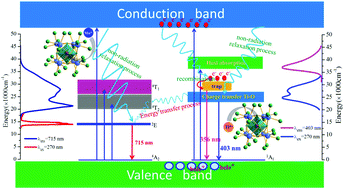Improved luminescence and energy-transfer properties of Ca14Al10Zn6O35:Ti4+,Mn4+ deep-red-emitting phosphors with high brightness for light-emitting diode (LED) plant-growth lighting
Abstract
For plant-growth lighting, novel deep-red emission phosphors with high brightness were obtained by co-doping Ti4+ and Mn4+ into a Ca14Al10Zn6O35 substrate through a conventional solid-state reaction strategy. The nominal Ca14−(x+y)/2Al10−x−yZn6O35:xTi4+,yMn4+ (CAZO:Ti4+,Mn4+) phosphors could be excited by both near-ultraviolet (NUV) and blue-light-emitting diode (LED) chips efficiently and exhibited a strong deep-red emission band ranging from 650 nm to 750 nm, which should be the result of the 2E → 4A2 transition inside the [MnO6]8− octahedral. Multiple energy transfer from Ti4+ to Mn4+ was detected in this CAZO; whereby Ti4+ and Mn4+ phosphors were verified to be a result of the dipole–dipole interaction under excitation at 270 nm. LED plant-growth lights were fabricated using the as-prepared nominal Ca13.825Al9.65Zn6O35:0.15Mn4+,0.2Ti4+,0.005H3BO3 (CAZO:Mn4+,Ti4+,H3BO3) phosphors pumped by a 460 nm blue-chip; this luminaire could be used to greatly promote the cultivation of succulent plants. Combined with the attractive thermal stability as well as high quantum efficiency (QE) of this phosphor, it was demonstrated that these novel phosphors may be candidate deep-red luminescent materials for LED plant lighting.



 Please wait while we load your content...
Please wait while we load your content...